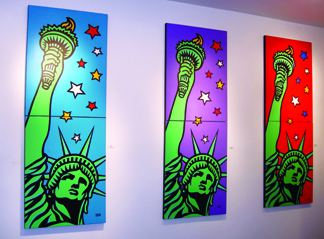Angst, Politics, and Art Appreciation
By GINGER LEE HENDLER
ART TIMES Sept/ Oct 2009
 Pop-arazzi B, by Burton Morris 2006, Acrylic on canvas, 60x48" Courtesy of Burton Morris Studios Pop-arazzi B, by Burton Morris 2006, Acrylic on canvas, 60x48" Courtesy of Burton Morris Studios |
I recently had a conversation with a friend about whether or not having some background about artists and their process enhances appreciation of their work. Does it help to know that van Gogh struggled with mental illness in order to fall in love with “A Starry Night”? Is it necessary to know who inspired Jackson Pollock and what his personal angst was before one can fully appreciate his drip paintings? And do we feel differently about “Guernica” when we research the political leanings of Picasso? Does it add greater meaning if we study the purpose and the process of the artist?
My friend argued that, as an art historian, she felt strongly that knowing about the history and the process is essential when viewing art. Although I agree on some level, I am strongly influenced by my senses, and my experience with art is mostly visceral. I may often be intellectually stimulated by conceptual art, but mostly I am drawn to color and energy. In the two exhibits that I review here, I take both sides under consideration. Sometimes as I walk through a museum or gallery I find myself listening to the conversations around me, and will often revisit a painting if I hear an interesting comment by a total stranger. On occasion I have heard docents give fascinating details about the personal, political, and professional struggles that artists encounter. I always find it illuminating. On the other hand, it doesn’t necessarily enhance my enjoyment of a work. They may say that “The Last Supper” is the epitome of classical art, but that doesn’t make it my favorite.
On my recent visit to the Emily Lowe Gallery at the Hofstra University Museum, I walked into the inaugural exhibit of the newly renovated space with the intention of inconspicuously reviewing Burton Morris’ show, “Pop”. Burton Morris had flown in from LA for the opening, and he came up to me and introduced himself. I politely requested that we meet after I had had a chance to view the work alone and take some notes. A reviewer’s work is best done with minimal distraction, so choosing an opening reception is almost certainly a conflict, yet I had scheduled enough quiet time prior to the opening. I also wanted to get the initial impression of the work without hearing any of the artist’s background, and certainly more so after my recent conversation with aforementioned art historian friend. I was putting myself in the midst of a sociological experiment.
As I wandered around the room, I took in the electric charge emanating from the paintings. I noticed that there were no gradations of color, no shading, and no visible brushstrokes. Morris’ images are not subtle. There is nothing quiet about them. They jump out at you, literally pop off the walls. Initially, I was taken by the vibrancy of the color and the strong images of American pop culture that embraced each wall. Several pieces are three-dimensional, with silk-screened pop-outs adding to the dynamism. Perhaps I would bring the family back for another look. My young grandchildren would definitely find it engaging. What child would not love the images of popcorn, Dick Tracy look-alikes and the Statue of Liberty in bold primary colors? This art is positive, and with the current trend of negativity in art we can all use a dose of Burton Morris’ work.
After doing my initial walk-through, I was finally ready to meet the artist. Burton Morris was charming and excited at the prospect of discussing his work and telling his story. Who he was, how he began the work, and why he chose the subject were all essential to this. He developed a connection with comic books at the age of three after breaking his femur bone. He began to draw while bedridden. Initially inspired by the work of Albrecht Dürer, Morris tried to emulate the fine pen and ink work of this classical artist’s etchings, using rapidograph pens for his tight drawings. Later he was influenced by the work of Andy Warhol, Tom Wesselman, Roy Lichtenstein, and Keith Haring. He was always looking for symbols that represented American culture: the coffee cup symbolizing the Starbucks revolution, slot machines for the gaming industry, and the popcorn box as the icon for the Hollywood era. In his artist’s statement he says, “My artwork celebrates beauty and life while projecting an optimistic sense of high energy and style.” Morris feels that “when people are under great stress art has the ability to lift us out. I defy anyone to leave this exhibit without smiling.”
|
He told me that he chooses to “paint objects and icons” and wants “to challenge the way we view everyday ideas in our modern day culture by representing the common object, reducing it to a common graphic form, and adding an energetic and colorful twist.” Had I not spoken to the artist and read the expository text I would have left the exhibit whistling a happy tune, but with no deeper understanding of the artist or his purpose. The flatness of the surface may be characteristic of the graphic nature of Pop Art, but the subtext is far from flat and is imbued with meaning. I left with a richer understanding in addition to my strong visceral reaction.
This is Poptimism in its fullest expression. And it’s for EVERYONE.
*”Burton Morris: Pop!” (thru Sep 27): Emily Lowe Gallery, Hofstra University Museum, 112 Hofstra University, Hempstead, NY 11549-1120 ( 516-463-5672) hofstra.edu/museum
My next jaunt was out to Westhampton Beach. I had heard about the Annual Outsider Art in the Hamptons, but always had scheduling issues. I was thrilled at the prospect of finally attending the 4th Annual Outsider Art in the Hamptons. The exhibit, which is taking place at Galerie BelAge in Moniebogue Manor on Moniebogue Lane, consists of over 100 paintings, sculptures, multi-media and video works done by over 40 trained and self-taught artists. I have been a lover of Outsider Art for many years and already had some prior knowledge, but I was determined not to let any of this influence me as I reviewed the exhibit. I wanted to be an innocent as I perused the work. This would not be easy.
As I mentioned earlier, art for me is very visceral and predominantly sensory, and as I walked through the quaint space I felt as though I had arrived at an amusement park fun- house. Hanging sculptures glared at me as they weaved through the gold brocade drapes in the front room. Wherever I looked I was held captive by bold, colorful images. Walls and floors were filled with dazzling, glittery surfaces and three-dimensional sculptures. Dynamic energy emanated throughout the room from every angle. I have always been inspired by the unconventionality of the work, and I wanted to just stand there breathing it all in. This, of course, was my visceral reaction. As the reviewer I would have to move beyond the intuitive and delve into the five W’s of journalism. Reason and research would have to merge with the sensory and subjective.
Each piece in the show holds its own vision and appeal, some with greater dynamism and others with quieter more reflective interest. Most were integrated with found objects and all have an unschooled primitive flavor. “Mommy, Daddy & Me”, a work by Candyce Brokaw, a self-taught visionary artist consists of six square canvases pieced together in a puzzle-like composition juxtaposing the features of the three figures. The family is broken, yet integrated at the same time. The baby appears to be securely held and is centrally placed. The figurative work is a moving narrative held together with bold brush strokes of color. In order to connect with her work it was not necessary to know that she is the founder of The Survivors Art Foundation, a non-profit organization dedicated to encourage healing through the arts.
Rondi Casey’s work adorns the front room of the gallery. Her figures fly through the air and are reminiscent of characters in children’s fairy tales, akin to those by the Brothers Grimm. After reading her bio, and gaining insight into her inspiration, my initial visceral response was not altered. The work of both women stands on its own.
Although I’ve been a fan of Outsider Art for many years, my visit to Galerie BelAge became an opportunity to expand my understanding of the purpose and process underlying the work. The term was coined in 1972 by art critic Robert Cardinal as a synonym for Art Brut (Raw Art-rough art). The French artist, Jean Dubuffet first used that term to define art created outside the boundaries of official culture. Much Outsider Art illustrates extreme mental states, unconventional ideas, or elaborate fantasy worlds. Visionary Art and Survivor Art are also included in this genre. It is thought that Hieronymus Bosch may have been one of the first visionary painters. Picasso and Kandinsky were supporters of Outsider Art in the belief that formal academic training corrupted artists, while self-taught artists were less encumbered by rules. Many of the artists in this exhibit have some degree of formal training, yet their images project a child-like naiveté and rawness, which is characteristic of the genre. Some of the work was reminiscent of Jean Michel Basquiat, the artist who became embraced by the art world in the 80s and died of a heroin overdose at the age of 27.
I have no conclusion to the initial question posed above. Should we even need to concern ourselves with such intellectual constructs when viewing art? Art has a way of elevating us to a higher level and breathing life into our souls. We become enriched by the experience. Suffice it to say, that the appreciation of art remains a very personal process. Please partake of your own art appreciation experiments by visiting the galleries, museums, and outdoor fairs that are currently available throughout our beautiful island.
*”The 4th Annual Outsider Art in the Hamptons” (thru Sep 8): Galerie BelAge, 8 Moniebogue Lane, Westhampton Beach, NY, (631)288-5082 galeriebelage.com)
A Look Ahead:
The Long Island Museum Presents “Long Island Masterworks on Paper” Drawings by Robert White, Watercolors by George Constant, Prints from the Screen Print Workshop July 25-October 25, 2009
This summer the Long Island Museum will unite the three genres of work, spanning seven decades, into one colorful and informative exhibition. In conjunction with the show, the museum invites amateur and professional artists to enter its juried art competition, Works on Paper. Prizes will be awarded to the top four artists submitting works on paper.
The Long Island Museum, 1200 Route 25A Stony Brook, NY 11790 (631) 751-0066 longislandmuseum.org

 Liberty, Burton Morris 2006 Acrylic o/c 80 x 30
Liberty, Burton Morris 2006 Acrylic o/c 80 x 30